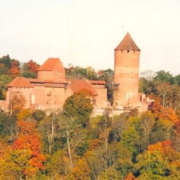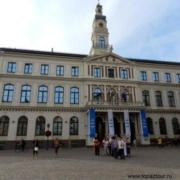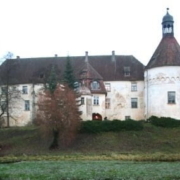Kropotkin Palace
 Kropotkin Palace.
Kropotkin Palace.
In the XVII century, a landowner estate began to form on the territory of Sigulda Castle. Several buildings have survived here, erected in the XVIII and XIX centuries during the time of the owners of von der Borchov and Kropotkin – Summer Castle, New Castle, White Castle, Burmistra’s House, manor houses, barn, laundry, cellars for root crops and vegetables.
The new palace (Kropotkin Palace) in Sigulda was built by Princess Olga Kropotkina, nee Countess von der Borch, in 1878 – 1882 on the site of the Order Castle. The Kropotkin Palace was built in the style of the Tudov neo-Gothic style from large, crafted, boulders. The work was supervised by a master mason Janis Mengelis.
Visiting the Kropotkin, who spent the summer months in this palace, many high-ranking guests from the capital visited.
During the First World War, the building was destroyed.
In 1921, the restored Kropotkin Palace passed into the possession of the state. In 1923, the Society of Journalists was housed in the palace. In 1930, the windows of the palace were installed stained glass M. Strunke “Four Seasons”. The building was installed picturesque work of K. Skuin.
In 1936-1937, in the palace – the House of Creativity or the Palace of the Press – perestroika was carried out. According to the project of architect A. Birkans, the height of the tower was increased. The interior authors are well-known Latvian artists of Latvia: Vilis Vasarinsh, Niklavs Strunke, Peteris Ozolins, Karlis Sunins.
During the Second World War, the Kropotkin Palace was used for the needs of the headquarters of the Nord German army. After the war, the USSR Council of Ministers placed a rest house for senior officials in the palace.
In 1953, the palace housed the Sigulda Cardiological and Climatic Sanatorium.
After the restoration of Latvia’s independence in 1991, the Kropotkin Palace was ceded to the state and since 2003 the Sigulda Duma, a restaurant has been located here.
Next to the New Castle is the so-called Yellow House (aka Summer Castle). It was built in the style of classicism at the turn of the 18th-19th centuries. A wooden longitudinal building was erected under the guidance of a master from the city of Cesis, called the last livin of Vidzeme, Marcis Sarums. Here the Kropotkins lived until the completion of the construction of the New Palace. There is also a small church where services were held for the owners of the estate.












Leave a Reply
Want to join the discussion?Feel free to contribute!